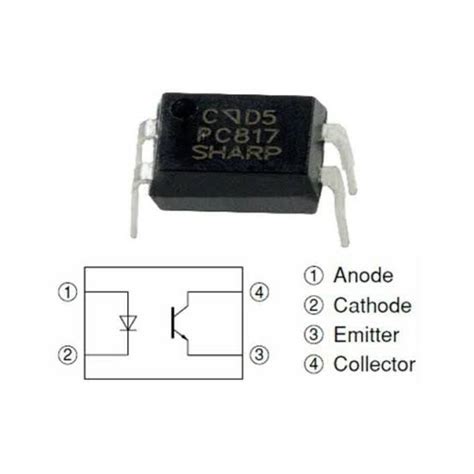How Does an Optocoupler Work?
The working principle of an optocoupler is based on the conversion of electrical energy into light energy and then back into electrical energy. The main components of an optocoupler are:
-
Light-emitting diode (LED): This is the input side of the optocoupler. When an electrical signal is applied to the LED, it emits light.
-
Photosensitive semiconductor device: This is the output side of the optocoupler. It can be a phototransistor, photodiode, or photo-SCR. When light from the LED falls on this device, it generates an electrical signal.
-
Transparent insulating medium: This is the material that separates the LED and the photosensitive device, providing electrical isolation between the input and output circuits.
When an electrical signal is applied to the LED, it emits light proportional to the current flowing through it. The light passes through the transparent insulating medium and falls on the photosensitive device. The photosensitive device then generates an electrical signal proportional to the intensity of the light it receives. This output signal is electrically isolated from the input signal, as there is no direct electrical connection between the two circuits.
Optocoupler Circuit Symbol and Pinout
The circuit symbol and pinout of an optocoupler depend on the type of photosensitive device used. Here are some common optocoupler configurations:
- Phototransistor Optocoupler:
| Pin | Function |
|---|---|
| 1 | Anode |
| 2 | Cathode |
| 3 | Emitter |
| 4 | Collector |
- Photodiode Optocoupler:
| Pin | Function |
|---|---|
| 1 | Anode |
| 2 | Cathode |
| 3 | Cathode |
| 4 | Anode |
- Photo-SCR Optocoupler:
| Pin | Function |
|---|---|
| 1 | Anode |
| 2 | Cathode |
| 3 | Gate |
| 4 | Cathode |
Advantages of Optocouplers
Optocouplers offer several advantages over other isolation methods:
-
Electrical isolation: Optocouplers provide complete electrical isolation between the input and output circuits, preventing ground loops, voltage spikes, and other electrical disturbances from propagating between the circuits.
-
High voltage isolation: Optocouplers can withstand high voltages between the input and output circuits, making them suitable for applications involving high-voltage switching or power supply isolation.
-
Noise immunity: Since the signal is transmitted optically, optocouplers are immune to electromagnetic interference (EMI) and radio frequency interference (RFI).
-
Wide operating temperature range: Optocouplers can operate over a wide temperature range, typically from -40°C to +85°C, making them suitable for harsh environmental conditions.
-
Compact size: Optocouplers are available in small packages, making them ideal for space-constrained applications.
Applications of Optocouplers
Optocouplers find applications in various fields, including:
-
Power supply isolation: Optocouplers are used to isolate the control circuitry from the high-voltage power supply circuitry, preventing damage to sensitive components and ensuring user safety.
-
Automotive electronics: In automotive applications, optocouplers are used to isolate the low-voltage control circuitry from the high-voltage battery and power systems.
-
Industrial control systems: Optocouplers are used in industrial control systems to isolate the control circuitry from the high-voltage and noisy industrial environment, preventing false triggering and ensuring reliable operation.
-
Medical equipment: In medical equipment, optocouplers are used to isolate the patient-connected circuitry from the main power supply, ensuring patient safety and preventing electrical shock hazards.
-
Telecommunications: Optocouplers are used in telecommunications equipment to isolate the sensitive communication circuitry from the high-voltage power supply and lightning-induced transients.

Choosing the Right Optocoupler
When selecting an optocoupler for a specific application, consider the following factors:
-
Input-output configuration: Choose an optocoupler with the appropriate photosensitive device (phototransistor, photodiode, or photo-SCR) based on the application requirements.
-
Current transfer ratio (CTR): CTR is the ratio of the output current to the input current. Select an optocoupler with a suitable CTR to ensure adequate signal transfer between the input and output circuits.
-
Isolation voltage: Ensure that the optocoupler has a sufficient isolation voltage rating to withstand the maximum voltage difference between the input and output circuits.
-
Switching speed: Consider the switching speed of the optocoupler, especially for high-frequency applications.
-
Package type: Optocouplers are available in various package types, such as DIP, SMD, and SOP. Choose a package that suits the application’s space and mounting requirements.
Optocoupler FAQs
-
Q: Can optocouplers be used for AC signal isolation?
A: Yes, optocouplers can be used for AC signal isolation by using a rectifier circuit on the input side to convert the AC signal to DC before applying it to the LED. -
Q: What is the maximum isolation voltage of an optocoupler?
A: The maximum isolation voltage of an optocoupler depends on the specific device and its construction. Some optocouplers can withstand isolation voltages up to 10 kV or more. -
Q: How does the current transfer ratio (CTR) affect optocoupler performance?
A: A higher CTR indicates better signal transfer efficiency between the input and output circuits. Optocouplers with higher CTRs require less input current to drive the output, making them suitable for low-power applications. -
Q: Can optocouplers be used for digital signal isolation?
A: Yes, optocouplers are commonly used for digital signal isolation. They can transmit digital signals between circuits while maintaining electrical isolation. -
Q: What is the difference between an optocoupler and a relay?
A: An optocoupler uses light to transfer signals between isolated circuits, while a relay uses an electromagnet to mechanically switch contacts. Optocouplers offer faster switching speeds, smaller size, and no moving parts compared to relays.
In conclusion, optocouplers are essential components in electronic systems that require electrical isolation and protection from voltage spikes, noise, and other disturbances. By understanding how optocouplers work, their advantages, and their applications, engineers and designers can select the most suitable optocoupler for their specific needs, ensuring reliable and safe operation of electronic devices.






Leave a Reply